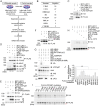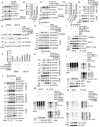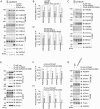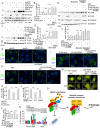VCP/p97 UFMylation stabilizes BECN1 and facilitates the initiation of autophagy
- PMID: 38762759
- PMCID: PMC11346537
- DOI: 10.1080/15548627.2024.2356488
VCP/p97 UFMylation stabilizes BECN1 and facilitates the initiation of autophagy
Abstract
Macroautophagy/autophagy is essential for the degradation and recycling of cytoplasmic materials. The initiation of this process is determined by phosphatidylinositol-3-kinase (PtdIns3K) complex, which is regulated by factor BECN1 (beclin 1). UFMylation is a novel ubiquitin-like modification that has been demonstrated to modulate several cellular activities. However, the role of UFMylation in regulating autophagy has not been fully elucidated. Here, we found that VCP/p97 is UFMylated on K109 by the E3 UFL1 (UFM1 specific ligase 1) and this modification promotes BECN1 stabilization and assembly of the PtdIns3K complex, suggesting a role for VCP/p97 UFMylation in autophagy initiation. Mechanistically, VCP/p97 UFMylation stabilizes BECN1 through ATXN3 (ataxin 3)-mediated deubiquitination. As a key component of the PtdIns3K complex, stabilized BECN1 facilitates assembly of this complex. Re-expression of VCP/p97, but not the UFMylation-defective mutant, rescued the VCP/p97 depletion-induced increase in MAP1LC3B/LC3B protein expression. We also showed that several pathogenic VCP/p97 mutations identified in a variety of neurological disorders and cancers were associated with reduced UFMylation, thus implicating VCP/p97 UFMylation as a potential therapeutic target for these diseases. Abbreviation: ATG14:autophagy related 14; Baf A1:bafilomycin A1;CMT2Y: Charcot-Marie-Toothdisease, axonal, 2Y; CYB5R3: cytochromeb5 reductase 3; DDRGK1: DDRGK domain containing 1; DMEM:Dulbecco'smodified Eagle's medium;ER:endoplasmic reticulum; FBS:fetalbovine serum;FTDALS6:frontotemporaldementia and/or amyotrophic lateral sclerosis 6; IBMPFD1:inclusion bodymyopathy with early-onset Paget disease with or withoutfrontotemporal dementia 1; LC-MS/MS:liquid chromatography tandem mass spectrometry; MAP1LC3B/LC3B:microtubule associated protein 1 light chain 3 beta; MS: massspectrometry; NPLOC4: NPL4 homolog, ubiquitin recognition factor;PIK3C3: phosphatidylinositol 3-kinase catalytic subunit type 3;PIK3R4: phosphoinositide-3-kinase regulatory subunit 4; PtdIns3K:phosphatidylinositol 3-kinase; RPL26: ribosomal protein L26; RPN1:ribophorin I; SQSTM1/p62: sequestosome 1; UBA5: ubiquitin likemodifier activating enzyme 5; UFC1: ubiquitin-fold modifierconjugating enzyme 1; UFD1: ubiquitin recognition factor in ERassociated degradation 1; UFL1: UFM1 specific ligase 1; UFM1:ubiquitin fold modifier 1; UFSP2: UFM1 specific peptidase 2; UVRAG:UV radiation resistance associated; VCP/p97: valosin containingprotein; WT: wild-type.
Keywords: BECN1/beclin 1; PtdIns3K complex; UFL1; UFMylation; VCP/p97.
Conflict of interest statement
No potential conflict of interest was reported by the author(s).
Figures





Similar articles
-
LUBAC and OTULIN regulate autophagy initiation and maturation by mediating the linear ubiquitination and the stabilization of ATG13.Autophagy. 2021 Jul;17(7):1684-1699. doi: 10.1080/15548627.2020.1781393. Epub 2020 Jun 26. Autophagy. 2021. PMID: 32543267 Free PMC article.
-
Members of the autophagy class III phosphatidylinositol 3-kinase complex I interact with GABARAP and GABARAPL1 via LIR motifs.Autophagy. 2019 Aug;15(8):1333-1355. doi: 10.1080/15548627.2019.1581009. Epub 2019 Mar 4. Autophagy. 2019. PMID: 30767700 Free PMC article.
-
Divergent roles of BECN1 in LC3 lipidation and autophagosomal function.Autophagy. 2015;11(5):740-7. doi: 10.1080/15548627.2015.1034404. Autophagy. 2015. PMID: 25955014 Free PMC article.
-
Organelle-specific autophagy in inflammatory diseases: a potential therapeutic target underlying the quality control of multiple organelles.Autophagy. 2021 Feb;17(2):385-401. doi: 10.1080/15548627.2020.1725377. Epub 2020 Feb 12. Autophagy. 2021. PMID: 32048886 Free PMC article. Review.
-
How autophagy controls the intestinal epithelial barrier.Autophagy. 2022 Jan;18(1):86-103. doi: 10.1080/15548627.2021.1909406. Epub 2021 Apr 27. Autophagy. 2022. PMID: 33906557 Free PMC article. Review.
Cited by
-
The mechanisms and effects of lactylation modification in different kinds of cancers.Discov Oncol. 2025 Apr 18;16(1):560. doi: 10.1007/s12672-025-02359-9. Discov Oncol. 2025. PMID: 40249419 Free PMC article. Review.
-
Unraveling the role of ufmylation in the brain.Neural Regen Res. 2026 Feb 1;21(2):667-668. doi: 10.4103/NRR.NRR-D-24-01311. Epub 2025 Jan 29. Neural Regen Res. 2026. PMID: 40326983 Free PMC article. No abstract available.
-
Akt-phosphorylated UFL1 UFMylates ArpC4 to promote metastasis.Nat Struct Mol Biol. 2025 Aug;32(8):1528-1541. doi: 10.1038/s41594-025-01576-8. Epub 2025 May 26. Nat Struct Mol Biol. 2025. PMID: 40419786
-
VCP Promotes Cholangiocarcinoma Development by Mediating BAP1 Ubiquitination-Dependent Degradation.Cancer Sci. 2025 Jun;116(6):1579-1591. doi: 10.1111/cas.70061. Epub 2025 Mar 23. Cancer Sci. 2025. PMID: 40122668 Free PMC article.
-
The many connections of UFMylation with Alzheimer's disease: a comprehensive review.Mol Neurodegener. 2025 Jun 4;20(1):66. doi: 10.1186/s13024-025-00855-8. Mol Neurodegener. 2025. PMID: 40468360 Free PMC article. Review.
References
Publication types
MeSH terms
Substances
LinkOut - more resources
Full Text Sources
Other Literature Sources
Molecular Biology Databases
Research Materials
Miscellaneous
